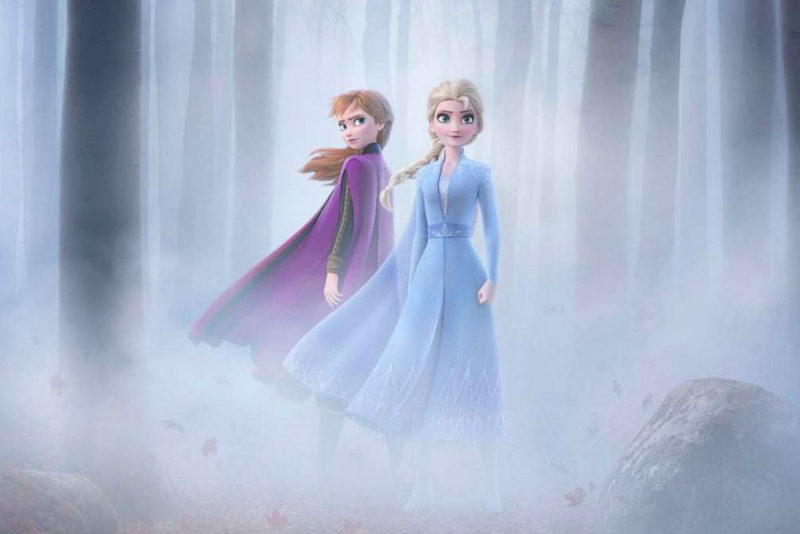Frozen II: Saved by Blessedly Superficial Viewers

Of the first Frozen movie, I probably wrote half a dozen articles. What was that magic ingredient that made it a plus-billion-dollar blockbuster, a culture-rocking achievement, a life-defining event for a whole generation of kids and their parents?
That’s a huge question. You can list every ingredient you want: the amazing characters, the charmed music, great story, beautiful animation, the right combination of drama plus bad guys plus humor. It’s impossible to identify a single element responsible for the greatness; somehow it all came together.
We all have a favorite thing about Frozen. For me it was the portrayal of bourgeois life in some uncertain Nordic country in some uncertain past, featuring normal merchants and regular people struggling to achieve peace and prosperity, plus the sad but ultimately triumphant story of estranged sisters who lived a once-lonely life in a castle but discovered together that love is a force that can heal the land. There was, of course, the epic emancipatory anthem of “Let It Go” complete with the magical construction of a glorious ice cathedral to individualism in the sky.
Unforgettable.
No sequel could possibly live up to the first, of that we can be certain. This is why so many of us had a slight sense of dread about Frozen II. We want to know more about this wonderful land and these people but are the producers up to the task? Would the creators find the reasons for the mighty achievement of the first and then reproduce them with an extended storyline that does no injury to the original ethos?
Olaf’s Frozen Adventure from 2017 (it’s only 20 minutes long) provided a reason for hope: it was an absolutely delightful story that captured many elements of the original that I liked. Or would Frozen II miss the reasons for the creative success of the first and instead default to a formula that draws mainly on the capital built up from the first effort to push some manipulative agenda?
I’ve spoken to many people who left the theater very happy with the movie. That’s good. Some people are screaming with delight. I wish I had been among them. But apparently, I’m the outlier here. The movie drew in $100 million on its opening weekend and the fan reviews are solid.
True, the animation is beyond-belief beautiful. Just remarkable. The clothing was spectacular, a dress designer’s dream come true. The music falls far short of the first but maybe that too is to be expected. At least three songs in the film attempt to capture the magic of Let It Go, but none come close. Still, “Show Yourself” is a powerful song.
My issues are as follows. I saw very little of the themes in the first that thrilled me so much. Instead, about halfway through, I suddenly felt browbeat by a pushy political agenda involving some of the most annoying features of contemporary high-brow debate, involving identitarianism, social justice, colonialism, industrial exploitation, race and ethnicity, environmental destruction, climate change, and group-based guilt and contrition.
All this was poured into a confused plot involving dark secrets of the family history, including a strained attempt to reframe Elsa and Anna as the product of a mixed-race/ethnicity marriage, and therefore tasked with righting historical wrongs even at the risk of destroying the town they are sworn to protect.
You can render this how you want. Maybe it is about, as one Twitter account said, “In order for us to save something, we need to sacrifice something. That is what we should do in our life. In order to save ourselves, sometimes we need to sacrifice things that are destroying us, relationships, friendships, efforts, money and more.” Great: if this is the takeaway, I have the sense that the creators will have missed their mark.
Again, for all the viewers who can look past all of this and just enjoy the movie, that’s fabulous. Once I saw the underlying ideological agenda – and fortunately, no younger viewer will see a bit of this in the film – I couldn’t unsee it.
I can’t shake the sense that the entire plot was crafted to address the original’s most fanatical critics on the left, who of course are not satisfied because they will never finally be satisfied. The New York Times even took after the sisters themselves: “the harmonious emotions and good intentions never fully atone for the conventionalism of the blond-on-blond character design, the tiny waists, pert breasts, jeweled eyes and pale plastic-y skin. Hearing women sing of freedom is irresistible, but Disney needs to take its old-fashioned ideal of female beauty and just, well, let it go.”
Catch the language of sin and atonement here? The critical theory that has dominated elite cultural criticism has become a faith so pervasive that it threatens to blot out the creative imagination that is essential to creative art. Everything, we are told, must conform to a political narrative to impose on the entire bourgeois order a deep sense of guilt for its very existence.
Even the Frozen franchise, one of the most successful in history, must be twisted to make this point or else face a brutal beating at the hands of the cultural elite. The writers and directors were very clearly kowtowing to this fear. Here is a paradigmatic case in which a political ideology gets in the way of producing art that speaks to the real complexities of the human experience and uplifts the spirit.
But here is what is interesting. I’m looking all over the Internet for people who saw what I saw. It’s there but you have to look for it. This lefty site celebrates the film:
[In Frozen II] climate justice moves from allegorical substrate to the centre of the story. Elsa is drawn Into the Unknown (the title of the soundtrack’s first single) by an ethereal voice that speaks for disordered nature…. Elsa’s icy powers may be able to stop elemental forest fire, but it is her determination to learn about and take responsibility for colonial climate crisis, in solidarity with an indigenous community, that we need as the forests of California, where the film was made, burn down.
To which I can only roll my eyes.
National Review too picked up on it:
Sometimes the Left’s enthusiasm for making amends for ancient iniquity looks like random punishment directed at innocent living people. Disney typically contents itself with selling a sort of mushy be-nice liberalism, but Frozen II may presage a turn to storylines that celebrate extremism. Are you ready for Woke Disney?
The great news is that, so far as I can tell, viewers aren’t very interested in the climate-crisis-post-colonial-critical-theory-identitarian elements of the story and prefer to think mainly about the cute fire gekko, Elsa’s taming of the water horse, and Anna’s awesome boots.
All to the good. May the public’s implacable superficiality save us from insufferable wokeness that threatens to ruin all the things we love.










